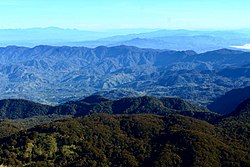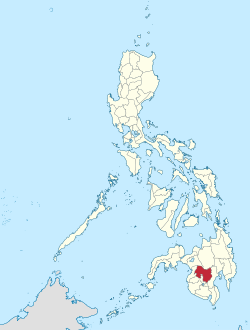|
Cotabato
Cotabato, formerly and still commonly referred to as North Cotabato[a] and officially the Province of Cotabato, is a landlocked province in the Philippines located in the Soccsksargen region in Mindanao. Its capital is the city of Kidapawan, the most populous in the province. Some of its municipalities are under the jurisdiction of the nearby Bangsamoro Autonomous Region. EtymologyThe name Kuta Watu in Maguindanaon (or Kota Batu in Malay) means "stone fortress".  HistoryMaguindanao SultanateAccording to Maguindanao royal records, Islam was introduced to the Maguindanaos in the late 15th century by Sharif Muhammad Kabungsuan, a Johorean Malay Muslim noble and missionary of Arab descent. Sharif Kabungsuan invaded Malabang in 1475, facing armed resistance from the principality, nevertheless successfully vanquishing and subjugating it to his Islamic rule through the employment of Samal forces.[3] Cotabato became the capital of the Maguindanao Sultanate. The city became the seat of power of Sultan Muhammad Kudarat in 1619. Spanish invasionChristianity was introduced in 1596, but the Spaniards were unable to penetrate into the region until the second half of the 19th century. The district of Cotabato was formed in 1860,[4] covering the areas of what is now Cotabato, Maguindanao del Norte, Maguindanao del Sur, and Sultan Kudarat provinces with its capital at Tamontaka. Fort Pikit was established by the Spaniards in 1893 as they continued their conquest of the remnants of Maguindanao Sultanate, which would soon be the site of one of the province's oldest towns, Pikit. American ruleThe coming of the Americans ushered in the creation of the Moro Province on July 15, 1903, through Act No. 787 of the Philippine Commission. Cotabato, covering what are now the provinces of Cotabato, Maguindanao del Norte, Maguindanao del Sur, Sultan Kudarat, South Cotabato and Sarangani, became a district of the huge Moro province. During the American period, large companies were established in Cotabato to exploit the vast timber resources of the region. By the 1930s, settlers from Luzon and Visayas established homesteads in Cotabato. Japanese invasionIn December 1941, Japanese planes bombed and invaded Cotabato. In 1942, Cotabato was occupied by the Japanese Imperial forces. A military headquarters of the Philippine Commonwealth Army existed in Cotabato from January 3, 1942, to June 30, 1946, and the Philippine Constabulary 10th Constabulary Regiment was stationed in Cotobato from October 28, 1944, to June 30, 1946. Moro guerrilla fighters operating in the province of Cotabato helped local forces of the Philippine Commonwealth Army and the Philippine Constabulary 10th Constabulary Regiment fight against the Imperial Japanese Army until 1944. The Moro guerrillas fought the Japanese troops until liberation. In 1945, Cotabato was recaptured from the Japanese Imperial forces by the combined Filipino and American troops together with the recognized Moro guerrilla units. The guerrillas used the traditional Moro Kampilan, Barong and Kris swords as their weapons. Postwar EraThe pace of settlement in the region accelerated in the 1950s and 1960s. The former province of Cotabato was once the largest in the Philippines. In 1966, South Cotabato was created as a separate province.[5] Mindanao, including Cotabato, was relatively peaceful in the 1950s and the mid-1960s. While there were some ethnic tensions, there was essentially no presence of secessionist groups in Mindanao yet.[6] During the Marcos dictatorshipThe relative peace of the postwar era began to change in the last years of President Ferdinand Marcos' first term, when news about the Jabidah massacre ignited a furor in the Moro community, and ethnic tensions encouraged with the formation of secessionist movements.[7] None of these groups had enough followers to form a viable opposition until Marcos declared Martial Law,[8] but when political parties were dissolved upon the proclamation of Martial Law in September 1972, it became easy for the armed secessionist group known as the Moro National Liberation Front to consolidate power, and the decades-long Moro conflict began in earnest.[9] One major event of Martial law which took place in Cotabato was the Manili massacre, which saw the mass murder of 70[10] to 79[11] Moros, including women and children, committed in a mosque in Manili, Carmen, North Cotabato, Philippines on June 19, 1971.[12] The Muslim residents of the town had gathered in their mosque to participate in a supposed peace talk with Christian groups when a group of armed men suspected to be part of the Ilaga militant group[10] opened fire on them.[12] On November 22, 1973, through Presidential Decree No. 341, what remained of the old Cotabato was further divided into the provinces of North Cotabato, Maguindanao, and Sultan Kudarat.[13] North Cotabato was later renamed Cotabato through Batas Pambansa Blg. 660 approved on March 7, 1984.[14] Post-1986By the aftermath of the plebiscite to form the autonomous administrative region of Bangsamoro in February 2019, 63 barangays from Cotabato's western municipalities, all of which inhabited mostly by Muslim natives, opted to join the newly formed region.[15] This will result in the reduction of the number of barangays the province currently administers after the national midterm elections on May 13, 2019.[16] Cotabato now comprises the capital city of Kidapawan and 25 municipalities. GeographyCotabato covers a total area of 9,008.90 square kilometres (3,478.36 sq mi)[17] occupying the northeastern tip of Region XII and is centrally located in Mindanao. It is bounded on the north by the provinces of Lanao del Sur and Bukidnon, on the east by Davao City and Davao del Norte, on the west by Maguindanao del Norte and Maguindanao del Sur, on the south by Sultan Kudarat, and on the southeast by Davao del Sur. Cotabato is strategically linked to the major "Arterial Road System" that traverses and connects the province to Davao City - Soccsksargen - Cotabato Corridor. The Cotabato via Kabacan - Maramag - Kibawe, Bukidnon Sayre Highway meanwhile serves as its link to the Cagayan de Oro-Iligan City Corridor. The Pan-Philippine Highway (AH26) traverses through the municipalities of Midsayap, Libungan and the Pigcawayan. Cotabato stretches from the east at Mount Apo, which separates it from Davao, to the Piapayungan Range on its boundary with Lanao in the west.[18] Between these highlands is the basin of the Pulangi River or Rio Grande de Mindanao,[18] the second longest in the Philippines at 373 kilometres (232 mi), which rises in Bukidnon and flows south to Maguindanao and Illana Bay. The province's fertile plains are traversed by tributaries of this great river. Typhoons do not pass through Cotabato and rainfall is evenly distributed throughout the year.[18]
Administrative divisionsCotabato comprises 25 municipalities and one city.[17] However, 8 municipalities are under the jurisdiction of Bangsamoro as part of its special geographic area.[20][21]  Political map of Cotabato
Reduction due to the establishment of the BangsamoroDuring the 2001 Referendum for inclusion to the Autonomous Region in Muslim Mindanao, 2 out of 28 barangays of Carmen, Cotabato chose to be part of ARMM, but were excluded because they are not connected to the main region of ARMM. During 2010-2016 Administration, the Bangsamoro ideal sprouted and a newly proposed region was in the making. According to the agreements signed by the Moro Islamic Liberation Front and the Administration of Noynoy Aquino, Carmen will be included in Bangsamoro because of the two out of twenty-eight barangays that voted in favor of joining the Muslim region back in 2001. Unfortunately, Bangsamoro was not implemented before the term of Aquino ended. Despite this, the current administration aims to establish a Federal Government, where Bangamoro will be realized into a State of the Philippines wherein Carmen will be included in Bangsamoro. Plans to establish a new municipality in the south of Carmen so that the indigenous and Christian central and northern part of Carmen will be retained in North Cotabato has yet to be confirmed. The idea arose because once the entire municipality of Carmen is included in Bangsamoro, the province of North Cotabato will be cut into half, leaving three towns (Banisilan, Alamada, and Libungan) at its west without connection to the center of North Cotabato, isolating these towns in the process. The issue was partially resolved when the second part of the plebiscite was conducted on February 6, 2019, when 63 barangay from the towns of Pigkawayan, Libungan, Midsayap, Aleosan, Carmen, Banisilan and Pikit opted to join the new administrative autonomous region of Bangsamoro after the results of the region's formation plebiscite were confirmed three days later on February 9.[15] These barangays are to join either the adjacent province of Maguindanao as parts of the said province's nearby and respective municipalities or to cluster on their own as new municipalities within the said province after the national midterm elections on May 13, 2019.[16] The size and population of Cotabato province had officially diminished on November 20, 2019, as the barangays which voted to join the Bangsamoro made their exit from the province and their respective mother municipalities and were officially turned over to the Bangsamoro government as an interim province within the autonomous region divided into several clusters.[24][25] Demographics
Based on the 2020 census, Cotabato has an overall population of 1,275,185.[2] The average population growth rate was 2.27% in the period 2010–2015, which is higher than the national average of 1.72%. The province had a density of 140 inhabitants per square kilometre or 360 inhabitants per square mile. Cotabato is an ethnolinguistically diverse province. The first Visayan settlers reached the town of Pikit in 1913, and since then, Christian migrants have moved and lived in Cotabato, cohabitating the province with the local indigenous groups. 71% of Cotabato's population descended from settlers who migrated from the Visayas and Luzon, while the remaining 18% belong to the communities of Magindanaons, Iranuns, Ilianens, Dulangan Manobo, Obo, Tagabawa, and Tboli. The major languages spoken are Hiligaynon (46%), Maguindanao (38%), Cebuano (8%), and Ilocano (4%).[18] ReligionCatholicismCotabato's population is predominantly Catholic. According to the 2020 census,[31] 52.77% of the population are Roman Catholic.[32] IslamAs of 2020, Muslims represent close to 20% of the population. OthersThe other significant minorities are Evangelical Christians at 8.4% of the population, Southern Baptist Church with 3.7% of the population, and Iglesia Ni Cristo which forms 2.2% of the Province population.[33] EconomyCotabato is considered a major food basket in Mindanao. It is a top producer of cereals, tropical fruits, vegetables, sugarcane, coconut, coffee, freshwater fish and livestock. It is also one of the country's leading producers of raw and semi-processed rubber and industrial trees,[42] with markets in Asia and Europe. Among its major natural assets are Mt. Apo, the country's highest peak at 9,692 feet (2,954 m) above sea level, the Pulangi River which is a major contributor to Mindanao's irrigation system and hydro-electric energy, and the vast Liguasan Marsh which not only supplies a bounty of freshwater fish and organic fertilizer but considered as a possible source as well of natural gas. Power utility in the province comes from two energy sources - the NAPOCOR Agus Grid in Iligan transmitted through its Tacurong Substations and the Mount Apo Geothermal Power Plant at the foot of Mt. Apo in Ilomavis, Kidapawan City which produces 97 megawatts of electricity. Power distribution is handled by Cotabato Electric Cooperative, Inc. (COTELCO). The province has a 4,131.32-kilometre (2,567.08 mi) road network connecting the major centers to each other and the outlying barangays, and communication linkage through NDD-IDD, fax, cellular phone and the internet is available. GovernmentPresident Benigno Aquino III signed the law dividing to new 3 legislative district of Cotabato on September 14, 2012. The representative shall continue to serve until next national election.[43] Elected provincial officials
Notable people
Notes
References
External links
Information related to Cotabato |
|||||||||||||||||||||||||||||||||||||||||||||||||||||||||||||||||||||||||||||||||||||||||||||||||||||||||||||||||||||||||||||||||||||||||||||||||||||||||||||||||||||||||||||||||||||||||||||||||||||||||||||||||||||||










